How To Fix My Cracked, Chipped or Broken Tooth
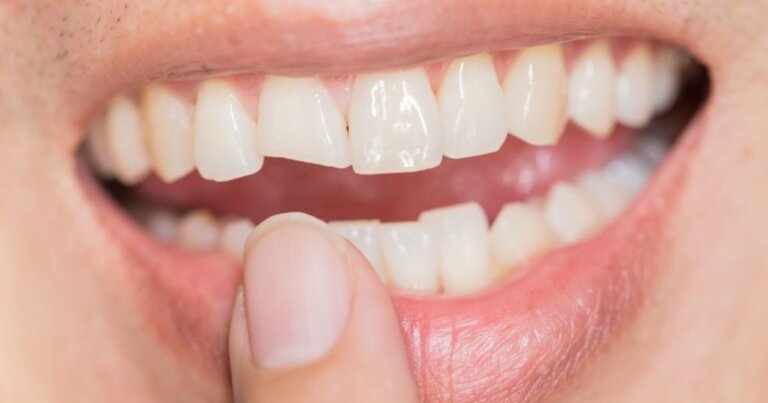
Help! I Have A Broken Tooth And Don’t Know What To Do!
If a piece of your tooth or tooth filling is broken, chipped or cracked, there is no need to panic. There is a good chance that the dentist can repair it with a filling, veneer or crown. Read more below to learn what you should do to care for your broken tooth before you visit a Toronto dentist.
What Causes A tooth To Crack, Chip or Break?
First, it’s important to note that it is not uncommon to crack, chip or break a tooth. Teeth can break out for any number of reasons:
- New areas of dental decay.
- Chewing on hard or crunchy foods.
- Bruxism, commonly known as teeth grinding, or teeth clenching.
- An accident or trauma to your tooth.
- The strength of the tooth is weakened from previously large dental work, such as root canal treatment, posts, and large fillings.
What Can The Dentist Do To Fix My Cracked, Chipped Or Broken Tooth?
Whether or not your broken tooth can be saved will depend on how much natural tooth structure remains above the gum. In order for any dental restoration to remain fixed to the root, there has to be sufficient tooth structure for it to hold onto. Small chips or breaks can be repaired with a simple dental filling. Larger breaks may require a porcelain veneer or dental crown.
A porcelain veneer is a ceramic facing that is glued on the front face of teeth; taking advantage of increased surface area for better bond strength and the high strength of porcelain for better material durability. They are commonly done on front teeth for cosmetic purposes.
A dental crown is a tooth-shaped cap that has more circumferential retention and will therefore last longer. Crowns are commonly chosen when posterior teeth are involved or if a tooth is too small or weak for veneers to work.
As a good rule of thumb, at least 1.5-2 millimeters of tooth height (ferrule) above the gum is required for tooth restorability. Sometimes, if it appears as if you do not have sufficient ferrule, the dentist can artificially increase the amount of available tooth structure by surgically reducing the surrounding gum and bone, revealing tooth roots below the gum line. This procedure is called crown lengthening surgery.
If your tooth is very broken, meaning that there is very little tooth structure above the gum or the broken portion of the tooth extends deep into the gums, then unfortunately the tooth is not salvageable and will require tooth removal followed by tooth replacement. Such broken teeth are commonly replaced with dental implants or dental bridges, and less commonly with dentures.
If you are experiencing tooth pain, it can mean that the nerve space inside the tooth has been exposed and will need root canal treatment to be saved. It could also mean that the tooth has cracked below the gum line and is causing pain in the gum and bone. In the latter scenario, the dentist cannot save the tooth and it should be extracted. It is important that you seek the help of a dentist to find out why the tooth hurts and if the tooth can be saved.
What Do I Do If My Tooth Is Cracked, Chipped Or Broken?
If you have broken a tooth, contact your Toronto dentist right away to make an appointment. You may be able to save the tooth with a filling, veneer, or crown. If you can’t seek a dentist immediately, you should take extra care of the tooth. Here are some steps you should take to protect the tooth:
- Keep the area as clean as possible. This is to prevent bacteria from attacking the exposed tooth surface. Brush and floss regularly, ideally after every meal. You can also swish with mouthwash or salt water for a clean antibacterial effect.
- Be careful to not eat or chew on the affected side. To prevent further pain or damage to the tooth, favor using the opposite side of your mouth.
- Avoid hot and cold food and drink if the tooth is sensitive or painful. Keep the food and drink you eat lukewarm or room temperature.
- If the tooth is sharp and is cutting your lip or tongue, cover the area with sugar-free gum, orthodontic wax, or an over-the-counter dental cement.
- If your teeth are sensitive or painful, take pain medication. Advil (ibuprofen) or Tylenol (acetaminophen) can provide a temporary relief and is available over the counter at your local pharmacy. Speak to your local pharmacist or dentist for a recommendation of what is right for you. The absolute maximum dose that I recommend patients take for the worst dental pain is 600mg ibuprofen with 1000mg acetaminophen every 4 to 6 hours.
- For direct pain relief on the exposed tooth and gum, apply clove oil or a topical numbing agent like Orajel.
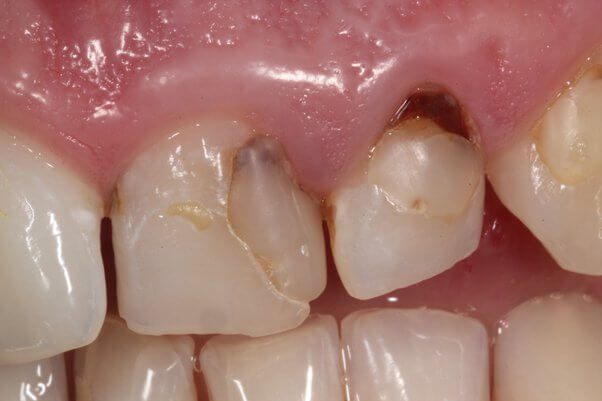
Whether it is an amalgam filling, composite resin filling, or glass ionomer filling, the cost of any of these Dental Fillings are similar and will depend on the location of the tooth (anterior, bicuspid or molar), as well as the size of the filling, which is translated as the number of “surfaces” involved. Imagine each tooth as a 5 surface box. Each “surface” that gets incorporated will dictate the size (and overall cost) of the tooth filling. Therefore, the cost of a filling can range between $200-460. The codes relevant to dental fillings in the Ontario Dental Association’s Suggested Fee Guide appear as follows:
Permanent Anteriors:
- 23111 – One surface: $200
- 23112 – Two surfaces: $250
- 23113 – Three surfaces: $300
- 23114 – Four surfaces: $370
- 23115 – Five surfaces (maximum surfaces per tooth): $390
Permanent Bicuspids:
- 23311 – One surface: $220
- 23312 – Two surfaces: $275
- 23313 – Three surfaces: $330
- 23314 – Four surfaces: $400
- 23315 – Five surfaces or maximum surfaces per tooth: $420
Permanent Molars:
- 23321 – One surface: $240
- 23322 – Two surfaces: $300
- 23323 – Three surfaces: $360
- 23324 – Four surfaces: $440
- 23325 – Five surfaces or maximum surfaces per tooth: $460
Dental Fillings are considered a basic service under all dental insurance plans and should be covered to your maximum insurable limit, but be sure to find out from your dental insurance plan provider how much you are eligible for before going ahead with dental treatment. Our fees are consistent with the ODA Fee Guide.
Cost of Dental Crown
The cost of a Dental Crown include the dentist’s professional fee ($1140), plus the dental laboratory’s fee ( approximately $200-500) in making the crown. The codes relevant to dental crowns in the Ontario Dental Association’s Suggested Fee Guide appear as follows:
Crowns, Porcelain/Ceramic/Polymer Glass
- 27201 – Crown, Porcelain/Ceramic/Polymer Glass: $1140 + Dental Lab Fee ($200-500)
There are a variety of dental crown materials to choose from. Some are more expensive than others. The three most common dental crown types listed in order from least expensive to most expensive are:
- All Ceramic crowns including Zirconia crowns and Lithium disilicate crowns
- Porcelain fused to metal crowns
- Full metal crowns, including Gold crowns
The Ontario Dental Association’s Suggested Fee Guide is a proposed fee structure that dentists in Ontario may or may not follow. Please consult with your dentist about fees before going ahead with treatment.
Dental crowns are considered a major restorative service under all dental insurance plans and may or may not be covered by your dental insurance. Be sure to find out from your dental insurance plan provider how much you are eligible for before going ahead with dental treatment. Your dentist can help you submit an predetermination to your dental insurance.
We also think you’ll like…
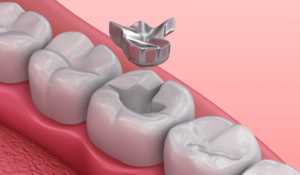
Amalgam Filling
Amalgam Filling What Is An Amalgam Filling? An Amalgam Filling is a dental restorative material used to repair teeth that have been compromised by dental
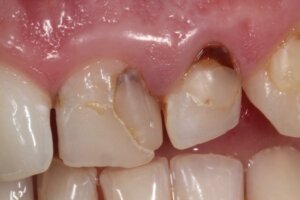
Discolored Filling
Discolored Filling What Is A Discolored Filling? Dental fillings are a common treatment for cavities and decay. They are typically made of a composite resin
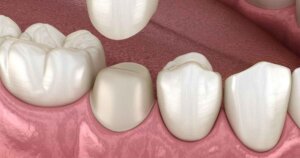
Fallen Out Dental Crown
Fallen Out Dental Crown What Is A Fallen Out Dental Crown? A dental crown is a type of dental restoration that is placed over a
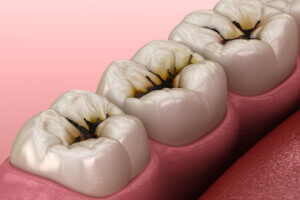
Irreversible Pulpitis
Irreversible Pulpitis What Is Irreversible Pulpitis? If you’ve ever experienced a sudden, sharp, and persistent toothache, you may be experiencing “Irreversible Pulpitis.” This dental condition,
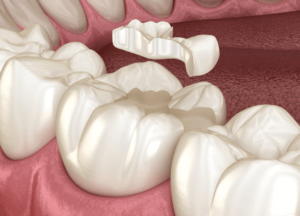
Porcelain Inlay
Porcelain Inlay What Is A Porcelain Inlay? A Porcelain Inlay is a type of dental restoration crafted from high-quality, biocompatible porcelain material. These restorations are
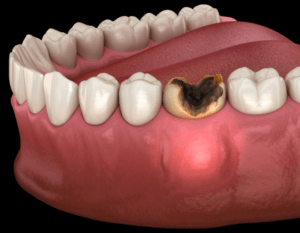
Pulp Necrosis
Pulp Necrosis What Is Pulp Necrosis? Pulp Necrosis is a dental condition that occurs when the innermost tissue of a tooth, known as the pulp,

